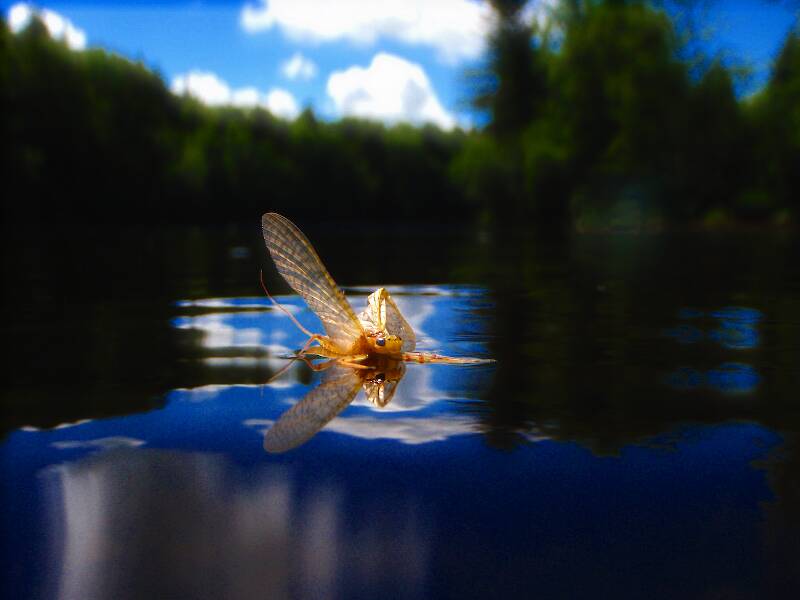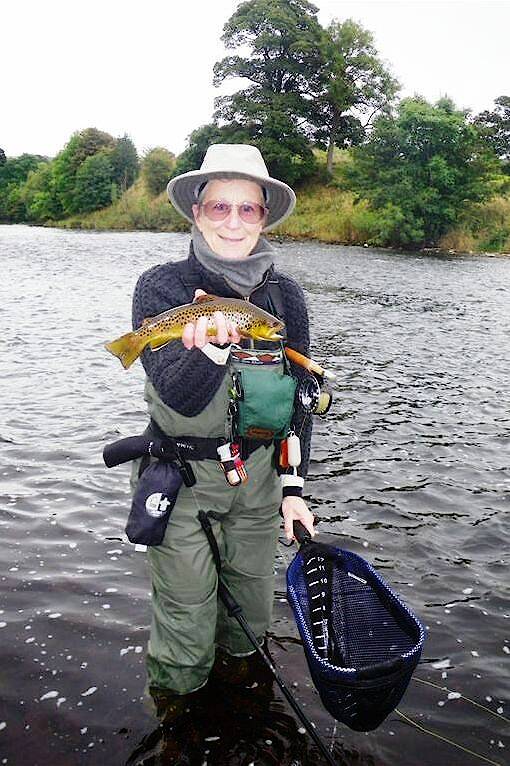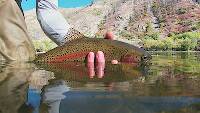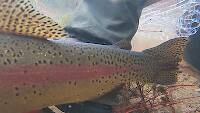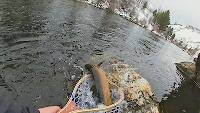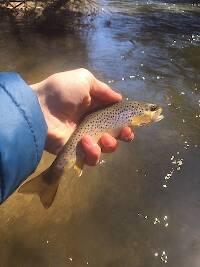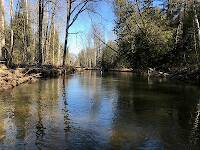
Salmonflies
Pteronarcys californica
The giant Salmonflies of the Western mountains are legendary for their proclivity to elicit consistent dry-fly action and ferocious strikes.
Featured on the forum

This wild-looking little thing completely puzzled me. At first I was thinking beetle or month larva, until I got a look at the pictures on the computer screen. I made a couple of incorrect guesses before entomologist Greg Courtney pointed me in the right direction with Psychodidae. He suggested a possible genus of Thornburghiella, but could not rule out some other members of the tribe Pericomini.

Troutnut is a project started in 2003 by salmonid ecologist Jason "Troutnut" Neuswanger to help anglers and
fly tyers unabashedly embrace the entomological side of the sport. Learn more about Troutnut or
support the project for an enhanced experience here.
Al514 on May 24, 2007May 24th, 2007, 2:46 pm EDT
The other night after work, I go to one of my favorite streams and was welcomed with rising fish. This stream is stocked, but not in the section I fished and was nice to get some wild fish. Its very rewarding to get these wild fish so I was very careful with them and want them to stay there. This might seem like a fundimental question, but after releasing the fish, do they go back to the same holding spots after being released or does catch and release totally change where the fish are/will be in the future?
Konchu on May 25, 2007May 25th, 2007, 2:06 am EDT
That's a good question. I've read some research that suggests most fish don't stray too far from one spot.
Has anyone read about catch and release survival rates?
Has anyone read about catch and release survival rates?
West on May 25, 2007May 25th, 2007, 4:37 am EDT
From my experience, trout seem to go back to their lies shortly after the release. I don't think a careful release of a fish will affect its permanent position in the stream or water it inhabits. It is not a concern of mine when I catch and release wild trout, as long as the fish being released is done so seiftly and carefully.
It would be very interesting to see some actual statistics of the mortality rate of released fish. I imagine it would be a hard study to conduct, considering the many variables (like type of hooks), but nonetheless a very interesting study.
It would be very interesting to see some actual statistics of the mortality rate of released fish. I imagine it would be a hard study to conduct, considering the many variables (like type of hooks), but nonetheless a very interesting study.
West
http://pleasantly-obsessed.blogspot.com/
http://pleasantly-obsessed.blogspot.com/
Luv2fish
Posts: 4
Posts: 4
Luv2fish on May 25, 2007May 25th, 2007, 4:55 am EDT
Hi there,
I have caught large sea-run trout in the same pool twice in a season, I could tell due to a large scar from an osprey or eagle tallon.
if you are a true conservationist then this will hold true, a perfect release of a large spawning fish is when there is no need to touch the fish...IE. Barbless hooks. yes it is nice to get a picture of the monsters, but it is also nice to see them go unharmed or touched at all also.
Let's be honest here, the most rewarding part about hooking a fish is knowing that the presentation had to have been perfect and we have read the water just right.
Take care!
I have caught large sea-run trout in the same pool twice in a season, I could tell due to a large scar from an osprey or eagle tallon.
if you are a true conservationist then this will hold true, a perfect release of a large spawning fish is when there is no need to touch the fish...IE. Barbless hooks. yes it is nice to get a picture of the monsters, but it is also nice to see them go unharmed or touched at all also.
Let's be honest here, the most rewarding part about hooking a fish is knowing that the presentation had to have been perfect and we have read the water just right.
Take care!
West on May 25, 2007May 25th, 2007, 5:26 am EDT
Just a quick sidenote,
I've heard of anglers that fish with hooks that have no point or bend. In other words, no mechanism of hooking the fish. I guess you could call it "strike and release." I think it's kind of cool that there are people out there, if that's true, that are satisfied with nothing more than the thought that they successfully decieved a fish. Personally, I prefer to get a close-up view of my catch, but like Luv2fish said, you don't HAVE to handle the fish.....
I've heard of anglers that fish with hooks that have no point or bend. In other words, no mechanism of hooking the fish. I guess you could call it "strike and release." I think it's kind of cool that there are people out there, if that's true, that are satisfied with nothing more than the thought that they successfully decieved a fish. Personally, I prefer to get a close-up view of my catch, but like Luv2fish said, you don't HAVE to handle the fish.....
West
http://pleasantly-obsessed.blogspot.com/
http://pleasantly-obsessed.blogspot.com/
Greenghost on May 25, 2007May 25th, 2007, 7:34 am EDT
West,I've read of the same practise.Amazingly enough,I've read the fish will actually hang on to a hookless fly sometimes for a few seconds.I'm pretty sure I've caught the same brookie twice in as many weeks on a small stream that I fish only 100' and 1 pool apart,only because it was well above average size for the stream?
Konchu on May 25, 2007May 25th, 2007, 3:09 pm EDT
I also have some vague memory of hearing that touching the fish can be as harmful, or more harmful than, hooking it. Removing their epidermal mucus layer can provide a route for infection. Knowing some good stats on all this would be interesting, but difficult to judge based on all the variables, as West mentioned.
Martinlf on May 26, 2007May 26th, 2007, 1:21 pm EDT
Having heard varying opinions about the mucus layer being removed by hands or nets and its possible effect on the fish, I finally bought one of the new rubber bag nets. I like it, but still wonder about the handling of fish and whether or not typical net bags or hands are harmful to fish. Will some of the fisheries biologists weigh in on this topic? David? Jason? Jason's dad?
"He spread them a yard and a half. 'And every one that got away is this big.'"
--Fred Chappell
--Fred Chappell
Shawnny3 on May 26, 2007May 26th, 2007, 3:24 pm EDT
Personally, I am morally opposed to anyone fishing with hooks that have no bend or point. Without the the bend and point, how could the endeavor possibly even qualify as flyfishing? Remove that one little protuberance and you completely emasculate the sport.
For example, without a bend and point, how would you ever get your fly stuck 20 feet up in a tree after finally pulling it free of the smallest rock in the stream? For that matter, how would you ever get hung up on the rock in the first place? And if you couldn't get hung up on every rock, stick, bush, leaf, lump of seaweed, plastic bag, tangle of monofilament, tire, pipe, rusted car bumper, refrigerator, lawnchair, and grocery cart, how would you ever find cause to wade right through your favorite spot to retrieve your fly? Or, in lieu of wading through that spot, how would you snap off a fly that you spent 30 minutes tying on your first clumsy cast? What would you spend the best 15 minutes of the hatch sharpening? How would you exponentially compound a simple windknot into a veritable rat's nest requiring the replacement of your entire leader? And, most obviously, what would you use on a windy day to impale yourself in the back of the neck? In sum, how would you transform an ostensibly relaxing activity into a rod-snapping rampage?
Strike and release, my a$$. That's no sport at all, if you ask me.
-Shawn
For example, without a bend and point, how would you ever get your fly stuck 20 feet up in a tree after finally pulling it free of the smallest rock in the stream? For that matter, how would you ever get hung up on the rock in the first place? And if you couldn't get hung up on every rock, stick, bush, leaf, lump of seaweed, plastic bag, tangle of monofilament, tire, pipe, rusted car bumper, refrigerator, lawnchair, and grocery cart, how would you ever find cause to wade right through your favorite spot to retrieve your fly? Or, in lieu of wading through that spot, how would you snap off a fly that you spent 30 minutes tying on your first clumsy cast? What would you spend the best 15 minutes of the hatch sharpening? How would you exponentially compound a simple windknot into a veritable rat's nest requiring the replacement of your entire leader? And, most obviously, what would you use on a windy day to impale yourself in the back of the neck? In sum, how would you transform an ostensibly relaxing activity into a rod-snapping rampage?
Strike and release, my a$$. That's no sport at all, if you ask me.
-Shawn
Jewelry-Quality Artistic Salmon Flies, by Shawn Davis
www.davisflydesigns.com
www.davisflydesigns.com
Greenghost on May 26, 2007May 26th, 2007, 4:59 pm EDT
Shawn,if you ever get up to NB I will personally offer expert instruction in the technique of getting your fly,or more correctly,your tippet stuck in a tree on the backcast while the fly(bend and point is optional)actually dangles in the breeze below the branch.It's quite simple really,you just have wrap the tippet around the branch several times,and then in a paniced state,make a forward casting motion at which time the fly will wrap itself over the tight line several more times.If you don't panic and calmly assess the situation,often times with gentle steady pressure the tippet will unwind from the branch and free itself along with the fly,but then you really don't have a good excuse to try a new pattern and must continue fishing with the one that hasn't raised a fish all day.
BTW,on the subject of handling trout,I've always been of the understanding that wetting your hands or better yet handling the trout in the water offered some degree of protection?Obviously the best scenario is to be able to remove the hook without touching the fish at all which is what I do whenever possible.With little brookies it is usually quite simple to slide my hand down the tippet,grasp the fly by the eye,and shake'em off.
BTW,on the subject of handling trout,I've always been of the understanding that wetting your hands or better yet handling the trout in the water offered some degree of protection?Obviously the best scenario is to be able to remove the hook without touching the fish at all which is what I do whenever possible.With little brookies it is usually quite simple to slide my hand down the tippet,grasp the fly by the eye,and shake'em off.
CaseyP on May 26, 2007May 26th, 2007, 5:43 pm EDT
Amazingly enough,I've read the fish will actually hang on to a hookless fly sometimes for a few seconds.
aha! now i know why i catch anything at all. i miss strike after strike and then somehow get one. if i take off the business end of the hook, may i count all those strikes instead of the one kamakazi fish i do eventually bring to (modern, non-harmful mesh) net?
"You can observe a lot by watching." Yogi Berra
Shawnny3 on May 27, 2007May 27th, 2007, 1:43 am EDT
Thank you, Ghost, for that instruction. I'll have to try that the next time I've got a brand-new leader on and I'm near a tree.
I must be a tremendous environmentalist, because I, like Casey, release most of my fish before bringing them within 20 feet of my hand. How nice to know that those fish aren't being "lost" but "long-released". I'd better go back and adjust the numbers in my fish log. And while I'm at it, I think those long-released fish were much, much bigger than the ones I actually measured before releasing.
Now that I think about it, there's a fine line between long-releasing fish and not fishing at all. Hmmm... yesterday I wasn't able to go fishing, so I spared a lot of fish (BIG fish) the minor inconvenience of striking my fly before I released them - talk about humane! One day, they'll write books about my exploits. My greatness is just well before its time.
-Shawn
I must be a tremendous environmentalist, because I, like Casey, release most of my fish before bringing them within 20 feet of my hand. How nice to know that those fish aren't being "lost" but "long-released". I'd better go back and adjust the numbers in my fish log. And while I'm at it, I think those long-released fish were much, much bigger than the ones I actually measured before releasing.
Now that I think about it, there's a fine line between long-releasing fish and not fishing at all. Hmmm... yesterday I wasn't able to go fishing, so I spared a lot of fish (BIG fish) the minor inconvenience of striking my fly before I released them - talk about humane! One day, they'll write books about my exploits. My greatness is just well before its time.
-Shawn
Jewelry-Quality Artistic Salmon Flies, by Shawn Davis
www.davisflydesigns.com
www.davisflydesigns.com
Konchu on May 27, 2007May 27th, 2007, 3:44 am EDT
Getting the fly stuck in the tree (followed by exclamations of displeasure), hooking oneself (followed by exclamations of displeasure), and splashing around in the stream are all part of "fair chase." That is why some people I know fire warning shots before taking an actual shot when hunting deer, turkies and other spooky creatures. I'm relatively certain such regulations are on the books, and enforced, in a number of states and provinces.
Beyond the long-release, isn't there a pre-emptive release technique?
Beyond the long-release, isn't there a pre-emptive release technique?
CaseyP on May 27, 2007May 27th, 2007, 7:02 am EDT
lessee, so far we have three kinds of releases, all supposedly okay for the fish:
1) CPR: catch, photograph, release
2) long-distance release: it splashed water, it was on the hook, it bent the rod, it gave great premature joy, it got away. Best Fishing Buddy and i count these as half a fish when writing the journal.
3) slack-line release: otherwise known as that noise the guide makes when you miss the strike...again...not counted in the journal, but marked by bad words, hopefully not too loud.
the tree-and-bunny-huggers have to approve!
1) CPR: catch, photograph, release
2) long-distance release: it splashed water, it was on the hook, it bent the rod, it gave great premature joy, it got away. Best Fishing Buddy and i count these as half a fish when writing the journal.
3) slack-line release: otherwise known as that noise the guide makes when you miss the strike...again...not counted in the journal, but marked by bad words, hopefully not too loud.
the tree-and-bunny-huggers have to approve!
"You can observe a lot by watching." Yogi Berra
Luv2fish
Posts: 4
Posts: 4
Luv2fish on May 28, 2007May 28th, 2007, 5:34 am EDT
I agree with David, water temp and barbless are always two things to keep in mind. If you can't land a fish with a barbless hook, try harder. I don't always fish that way, but hey if the fishing is good, we always need a one that got away story.
it is all relative, everyone has their own opinion and view. Personally, just getting out and seeing active fish on the water is half of the battle. Hooking a few of the completes the day and watching them return to their rivers unharmed makes me want to return.
it is all relative, everyone has their own opinion and view. Personally, just getting out and seeing active fish on the water is half of the battle. Hooking a few of the completes the day and watching them return to their rivers unharmed makes me want to return.
Martinlf on May 28, 2007May 28th, 2007, 6:42 am EDT
Thanks for the replies so far. After reading some of the barbed vs. barbless debate several years ago I went back to barbed, and I do believe I landed more fish. This year, though, after having trouble unhooking a fish, I've gone back to barbless. Though I've long and short line released several fish I really wish I had a better look at, I feel better about my reconversion to a mostly barbless approach, and this thread confirms my determination to debarb most of my flies. I do fish some very small Varivas hooks that have wide gaps and tiny barbs, and have never had any trouble removing one of them quickly, so I continue to leave them as is. Some have argued that small hooks can move around and create multiple stab wounds, so they are possibly better off with microbarbs. If I ever do have trouble with hook removal on one of the flies tied on these, I'll debarb them too also.
"He spread them a yard and a half. 'And every one that got away is this big.'"
--Fred Chappell
--Fred Chappell
Konchu on May 28, 2007May 28th, 2007, 3:02 pm EDT
David: I really need to say thanks to you for a couple of things:
1) bringing this discussion back on topic
2) sharing some really informative and interesting information!
1) bringing this discussion back on topic
2) sharing some really informative and interesting information!
Shawnny3 on May 29, 2007May 29th, 2007, 2:08 pm EDT
Yes, thank you David for saving us from ourselves and offering some solid information. The part about water temperature I found particularly helpful.
Thanks,
Shawn
Thanks,
Shawn
Jewelry-Quality Artistic Salmon Flies, by Shawn Davis
www.davisflydesigns.com
www.davisflydesigns.com
Martinlf on May 30, 2007May 30th, 2007, 1:09 am EDT
I've used 70 degrees F as my cut off for trout fishing generally. If it's higher, I fish for bass or stay home. How does this sound to the fisheries biologists?
"He spread them a yard and a half. 'And every one that got away is this big.'"
--Fred Chappell
--Fred Chappell
Macgruber on May 30, 2007May 30th, 2007, 4:04 am EDT
last year on the bighorn i caught a 23" rainbow in a large side channel along with a bunch of others in april...... came back in july with a buddy and after checking the photos from my april trip and comparing them to a fish he pulled, found that we caught the same fish not 30 yds from the hole i'd caught it in april..... the monster kype and the age of the fish were dead give-aways.....
also, to echo virtually everyone else..... go barbless...... esp. fishing with light line..... it's not just the release, but also the hook-sets which end up being a little too vigorous..... line snaps, fish ends up with a fly or two dragging behind it...... you gotta figure it's got a better shot at throwing the hooks if they are barbless...... i forgot to crush 'em on timber coulee and snapped off a large one earlier this year and it's still buggin me..... he's got a caddis and parachute adams wrapped around him....
also, to echo virtually everyone else..... go barbless...... esp. fishing with light line..... it's not just the release, but also the hook-sets which end up being a little too vigorous..... line snaps, fish ends up with a fly or two dragging behind it...... you gotta figure it's got a better shot at throwing the hooks if they are barbless...... i forgot to crush 'em on timber coulee and snapped off a large one earlier this year and it's still buggin me..... he's got a caddis and parachute adams wrapped around him....
Quick Reply
Related Discussions
Topic
Replies
Last Reply
4
Jul 25, 2019
by Iasgair
by Iasgair
22
Aug 2, 2010
by Oldredbarn
by Oldredbarn


